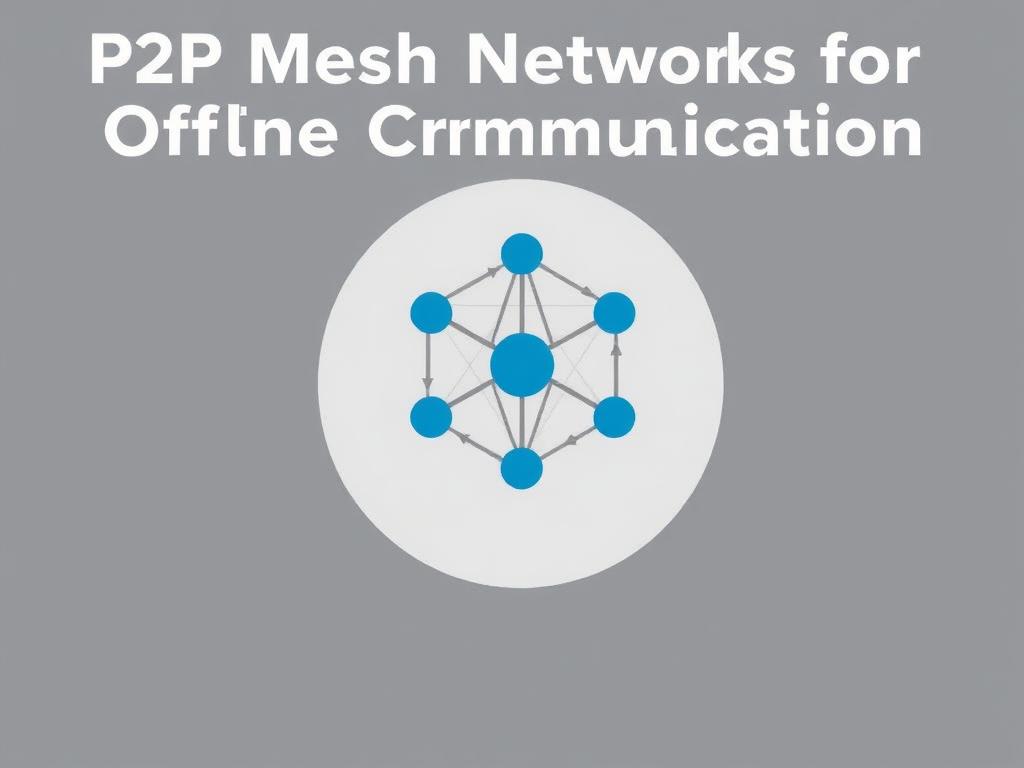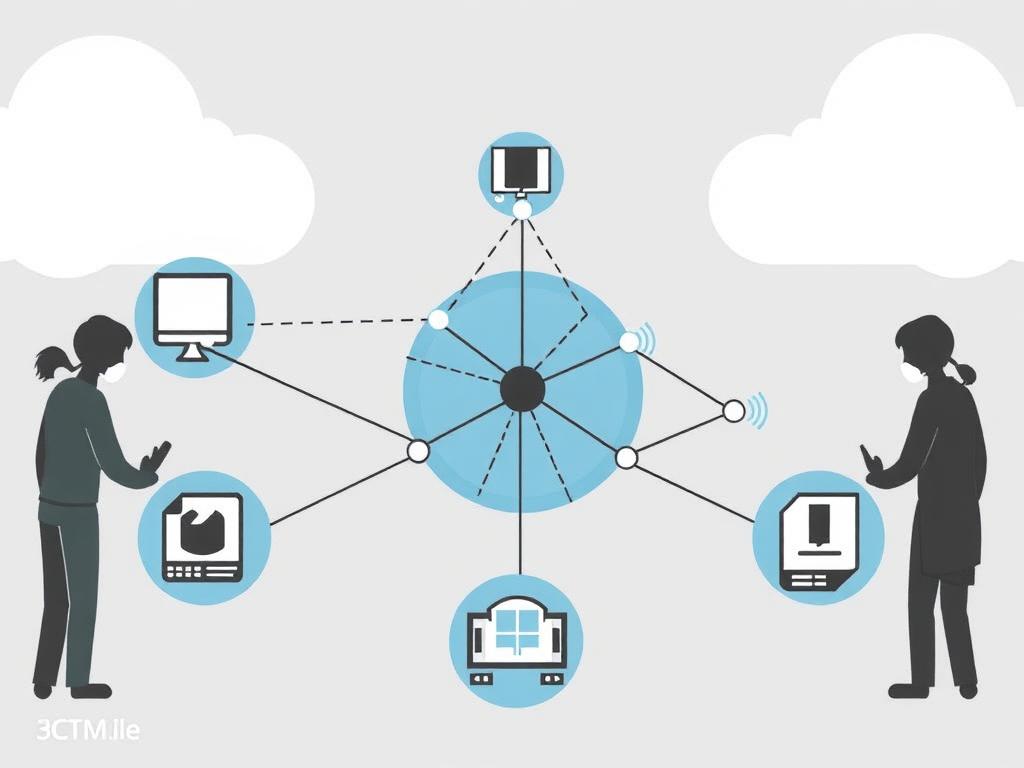P2P Mesh Networks for Offline Communication: Revolutionizing Connectivity When the Internet Fails
In today’s hyper-connected world, the internet has become a lifeline, linking billions of people and devices globally. However, what happens when this lifeline is cut off—due to natural disasters, remote locations, or intentional censorship? This is where P2P mesh networks for offline communication step into the spotlight, offering inventive solutions for maintaining connectivity without relying on centralized infrastructure. These networks, built on peer-to-peer principles, enable devices to communicate directly with one another, forming dynamic, decentralized webs that can operate independently of the internet.
Imagine a world where your smartphone can send messages, share files, or even access information through a swarm of nearby devices, all without requiring Wi-Fi or cellular signals. P2P mesh networks make this possible by leveraging nearby nodes to relay data across a network that can adapt and grow organically. In this article, we’ll explore how P2P mesh networks for offline communication work, their practical applications, the technology behind them, and their potential to transform how we stay connected when traditional communication methods fail.
Understanding P2P Mesh Networks for Offline Communication
So, what exactly is a P2P mesh network? At its core, “P2P” stands for peer-to-peer, a decentralized communication model where each participant, or node, acts both as a client and a server. This contrasts sharply with typical client-server models, where devices depend on centralized hubs like ISPs or cloud services to exchange data.
A mesh network, on the other hand, is a network topology where each node connects directly, dynamically, and non-hierarchically to as many other nodes as possible. Such connections create multiple redundant communication paths, significantly boosting resilience and reliability.
When combined, P2P mesh networks facilitate offline communication by allowing devices to connect directly with their neighbors, forwarding information node by node until the message reaches its destination. The process doesn’t need fixed infrastructure such as cell towers or routers, making these networks particularly valuable in environments with limited or no internet access.
How Does a P2P Mesh Network Work?
Let’s break down the core functioning of these networks into digestible steps:
- Discovery: Devices scan for nearby peers using Bluetooth, Wi-Fi Direct, or other short-range wireless technologies.
- Connection Establishment: Once peers are discovered, devices establish secure connections to form the mesh.
- Data Routing: Information is passed from one node to the next in a hop-by-hop fashion until it arrives at the recipient.
- Dynamic Reconfiguration: As nodes move or drop offline, the network rearranges itself automatically to maintain communication paths.
This dynamic nature is what differentiates mesh networks from traditional star networks and adds immense fault tolerance—if one node fails, traffic reroutes through others.
Technology Behind P2P Mesh Networks
The development of P2P mesh networks relies on a mix of software protocols and hardware capabilities. Most smartphones and laptops today come equipped with wireless technologies like Wi-Fi and Bluetooth that make short-range communication feasible. However, software components are crucial to managing peer discovery, data routing, encryption, and error correction.
| Technology Aspect | Description | Role in Mesh Network |
|---|---|---|
| Bluetooth Low Energy (BLE) | Short-range, low-power communication | Enables device discovery and lightweight messaging |
| Wi-Fi Direct | Peer-to-peer wireless connection without router | Allows high-speed data transfer between devices |
| Delay Tolerant Networking (DTN) Protocols | Protocols for handling network disruptions | Improve reliability in environments with intermittent connectivity |
| Routing Algorithms (e.g., AODV, OLSR) | Dynamic route discovery techniques | Find optimal paths for data packets in the mesh |
| End-to-End Encryption | Secure communication standard | Protects privacy and data integrity in P2P exchanges |
Developers also face challenges in balancing energy consumption and ensuring scalability, as mesh networks grow or shrink organically based on node participation.
Applications of P2P Mesh Networks for Offline Communication
Offline communication using P2P mesh networks unlocks new possibilities across various sectors and scenarios:
- Disaster Relief: Following natural disasters, infrastructure often gets damaged, making traditional communication impossible. Mesh networks can rapidly form to aid coordination among rescue teams and affected individuals.
- Remote Areas: In regions without reliable cellular networks or internet access, mesh technology allows communities to establish local communication and share resources.
- Events and Festivals: Large gatherings sometimes overwhelm cellular towers. Mesh networks can relieve congestion by providing local messaging and file-sharing.
- Activism and Censorship Circumvention: In nations with strict internet censorship, mesh networks empower users to share information freely without fear of surveillance or shutdown.
- Military and Tactical Uses: Field units can maintain communication without relying on vulnerable infrastructure.
Popular Apps and Tools Utilizing P2P Mesh Networks

Several innovative apps have incorporated mesh networking to enable offline communication, demonstrating the technology’s versatility and real-world value:
| App/Tool | Main Features | Use Case |
|---|---|---|
| FireChat | Offline messaging via mesh; no internet required | Used in protests and events with limited connectivity |
| Bridgefy | Bluetooth mesh for texting and location sharing | Disaster response, large gatherings |
| GoTenna | Hardware device creating mesh networks for message relay | Outdoor adventures, emergency communication |
| Serval Project | Open-source mesh networking app for voice and data | Remote areas, disaster zones |
Challenges and Future Prospects
Despite its promise, P2P mesh networks for offline communication face several challenges. Scalability is a significant concern since the network’s performance depends heavily on active node density; too few devices mean limited reach. Energy consumption is another hurdle, especially for mobile devices that need to maintain constant connectivity without draining batteries rapidly.
Security and privacy also require ongoing attention. While mesh networks inherently avoid centralized failure points, vulnerabilities can arise if nodes are compromised or if routing protocols are exploited. Developers continue to refine encryption and authentication mechanisms to tackle these issues head-on.
Looking ahead, the integration of mesh networking with emerging technologies like 5G and edge computing presents exciting avenues. Hybrid architectures could combine the benefits of centralized internet infrastructure with the resilience of decentralized local networks, ensuring seamless communication in even the most challenging situations.
Advantages at a Glance
- No dependency on centralized infrastructure
- Resilient to network failures and censorship
- Decentralized, scalable with the number of participants
- Low latency in localized communication
- Promotes community-driven connectivity
Limitations to Consider

- Limited range per device—requires sufficient network density
- Potentially high battery usage
- Complex routing and network management
- Data throughput can be slower than traditional networks
- Maintenance of security and trust challenging in open networks
Conclusion

P2P mesh networks for offline communication are reshaping how we think about connectivity in an increasingly digital world. By empowering devices to collaborate directly, mesh networks break free from the constraints and vulnerabilities of centralized internet infrastructure. Whether responding to disasters, bridging communication gaps in remote areas, or navigating internet blackouts, these networks offer a lifeline that keeps people connected when they need it most. As technology evolves, improving scalability, security, and energy efficiency, P2P mesh networks could become not just a niche solution but a fundamental component of our global communication landscape, ensuring that no one is ever truly out of reach.






